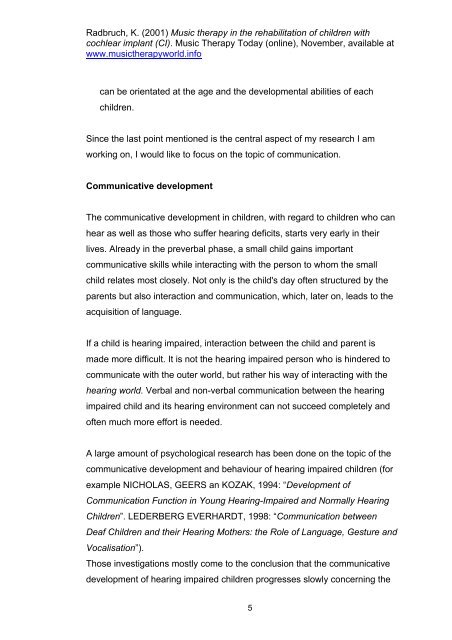Music therapy in the rehabilitation of children - World Federation of ...
Music therapy in the rehabilitation of children - World Federation of ...
Music therapy in the rehabilitation of children - World Federation of ...
Create successful ePaper yourself
Turn your PDF publications into a flip-book with our unique Google optimized e-Paper software.
Radbruch, K. (2001) <strong>Music</strong> <strong><strong>the</strong>rapy</strong> <strong>in</strong> <strong>the</strong> <strong>rehabilitation</strong> <strong>of</strong> <strong>children</strong> with<br />
cochlear implant (CI). <strong>Music</strong> Therapy Today (onl<strong>in</strong>e), November, available at<br />
www.music<strong><strong>the</strong>rapy</strong>world.<strong>in</strong>fo<br />
can be orientated at <strong>the</strong> age and <strong>the</strong> developmental abilities <strong>of</strong> each<br />
<strong>children</strong>.<br />
S<strong>in</strong>ce <strong>the</strong> last po<strong>in</strong>t mentioned is <strong>the</strong> central aspect <strong>of</strong> my research I am<br />
work<strong>in</strong>g on, I would like to focus on <strong>the</strong> topic <strong>of</strong> communication.<br />
Communicative development<br />
The communicative development <strong>in</strong> <strong>children</strong>, with regard to <strong>children</strong> who can<br />
hear as well as those who suffer hear<strong>in</strong>g deficits, starts very early <strong>in</strong> <strong>the</strong>ir<br />
lives. Already <strong>in</strong> <strong>the</strong> preverbal phase, a small child ga<strong>in</strong>s important<br />
communicative skills while <strong>in</strong>teract<strong>in</strong>g with <strong>the</strong> person to whom <strong>the</strong> small<br />
child relates most closely. Not only is <strong>the</strong> child's day <strong>of</strong>ten structured by <strong>the</strong><br />
parents but also <strong>in</strong>teraction and communication, which, later on, leads to <strong>the</strong><br />
acquisition <strong>of</strong> language.<br />
If a child is hear<strong>in</strong>g impaired, <strong>in</strong>teraction between <strong>the</strong> child and parent is<br />
made more difficult. It is not <strong>the</strong> hear<strong>in</strong>g impaired person who is h<strong>in</strong>dered to<br />
communicate with <strong>the</strong> outer world, but ra<strong>the</strong>r his way <strong>of</strong> <strong>in</strong>teract<strong>in</strong>g with <strong>the</strong><br />
hear<strong>in</strong>g world. Verbal and non-verbal communication between <strong>the</strong> hear<strong>in</strong>g<br />
impaired child and its hear<strong>in</strong>g environment can not succeed completely and<br />
<strong>of</strong>ten much more effort is needed.<br />
A large amount <strong>of</strong> psychological research has been done on <strong>the</strong> topic <strong>of</strong> <strong>the</strong><br />
communicative development and behaviour <strong>of</strong> hear<strong>in</strong>g impaired <strong>children</strong> (for<br />
example NICHOLAS, GEERS an KOZAK, 1994: “Development <strong>of</strong><br />
Communication Function <strong>in</strong> Young Hear<strong>in</strong>g-Impaired and Normally Hear<strong>in</strong>g<br />
Children”. LEDERBERG EVERHARDT, 1998: “Communication between<br />
Deaf Children and <strong>the</strong>ir Hear<strong>in</strong>g Mo<strong>the</strong>rs: <strong>the</strong> Role <strong>of</strong> Language, Gesture and<br />
Vocalisation”).<br />
Those <strong>in</strong>vestigations mostly come to <strong>the</strong> conclusion that <strong>the</strong> communicative<br />
development <strong>of</strong> hear<strong>in</strong>g impaired <strong>children</strong> progresses slowly concern<strong>in</strong>g <strong>the</strong><br />
5

















